 | |
| Original title | Добрейшово евангелие |
|---|---|
| Country | Bulgaria |
Publication date | 13th century |
| Media type | ink and gouache on parchment |
| Pages | 175 |
| SS. Cyril and St. Methodius National Library | |
Dobreyshovo gospel is a Bulgarian monument of the early 13th century.
 | |
| Original title | Добрейшово евангелие |
|---|---|
| Country | Bulgaria |
Publication date | 13th century |
| Media type | ink and gouache on parchment |
| Pages | 175 |
| SS. Cyril and St. Methodius National Library | |
Dobreyshovo gospel is a Bulgarian monument of the early 13th century.
The manuscript is ink and illumination on a total of 175 parchment leaves. It is located at the SS. Cyril and Methodius National Library, Bulgaria. [1]
The Gospel was written, according to a much later note added to it, before 1221, according to the scholars Wolf and Stresa[ who? ]. It is decorated with colorful ornamentation and images of the Evangelists Luke and John. The latter appears with a small kneeling figure, accompanied by the caption "pray to St. John"; the figure is believed to represent the priest Dobreysho (or Dobreisho), who probably paid for the parchment and either commissioned or made a copy of the book. [2]
The manuscript was found in Tulcea, Romania. Records indicate that it earlier was in Edirne. The majority of it (127 sheets) is now in the National Library "St.. St. Cyril and Methodius" (№ 17). The remaining 48 leaves were kept in Belgrade during the Second World War and did not survive the fire after the museum was hit by a bomb in 1941.
The language of the monument is close to Old Church Slavonic but shows some important new features.


The Glagolitic script is the oldest known Slavic alphabet. It is generally agreed that it was created in the 9th century by Saint Cyril, a monk from Thessalonica. He and his brother Saint Methodius were sent by the Byzantine Emperor Michael III in 863 to Great Moravia to spread Christianity among the West Slavs in the area. The brothers decided to translate liturgical books into the contemporary Slavic language understandable to the general population, and Cyril decided to invent a new script, Glagolitic, which he based on the local dialect of the Slavic tribes from around Thessalonica. After the deaths of Cyril and Methodius, the Glagolitic alphabet ceased to be used in Moravia for political or religious needs.

The Codex Sinaiticus, designated by siglum א [Aleph] or 01, δ 2, also called Sinai Bible, is a fourth-century Christian manuscript of a Greek Bible, containing the majority of the Greek Old Testament, including the deuterocanonical books, and the Greek New Testament, with both the Epistle of Barnabas and the Shepherd of Hermas included. It is written in uncial letters on parchment. It is one of the four great uncial codices. Along with Codex Alexandrinus and Codex Vaticanus, it is one of the earliest and most complete manuscripts of the Bible, and contains the oldest complete copy of the New Testament. It is a historical treasure, and using the study of comparative writing styles (palaeography), it has been dated to the mid-fourth century.

Cyril and Methodius (815–885) were brothers, Byzantine Christian theologians and missionaries. For their work evangelizing the Slavs, they are known as the "Apostles to the Slavs".
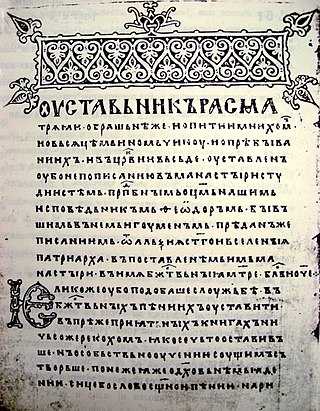
Old Church Slavonic or Old Slavonic is the first Slavic literary language.

Naum (Bulgarian and Macedonian: Свети Наум, Sveti Naum, also known as Naum of Ohrid or Naum of Preslav, was a medieval Bulgarian writer and missionary among the Slavs, considered one of the Seven Apostles of the First Bulgarian Empire. He was among the disciples of Cyril and Methodius and is associated with the creation of the Glagolitic and Cyrillic script. Naum was among the founders of the Pliska Literary School. Afterwards Naum worked at the Ohrid Literary School. He was among the first saints declared by the Bulgarian Orthodox Church after its foundation in the 9th century. The mission of Naum played significant role by transformation of the local Early Slavs into Bulgarians.
Constantine of Preslav was a medieval Bulgarian scholar, writer and translator, one of the most important men of letters working at the Preslav Literary School at the end of the 9th and the beginning of the 10th century. Biographical evidence about his life is scarce but he is believed to have been a disciple of Saint Methodius. After the saint's death in 885, Constantine was jailed by the Germanic clergy in Great Moravia and sold as slave in Venice. He escaped to Constantinople, moving to Bulgaria around 886 and working at the Preslav Literary School.

The SS. Cyril and Methodius National Library is the national library of Bulgaria, situated in the capital city of Sofia. Founded on 4 April 1878, the library received the status of Bulgarian National Library three years later and the Bulgarian National Revival Archive was merged into it in 1924.

The Ostromir Gospels is the oldest dated book of Kievan Rus'. Archeologists have dated the Novgorod Codex, a wax writing tablet with excerpts from the Psalms, discovered in 2000, to an earlier time range, but unlike the Ostromir Gospels, it does not contain an explicit date. The Ostromir Gospels was created by deacon Gregory for his patron, Posadnik Ostromir of Novgorod, in 1056 or 1057, probably as a gift for a monastery.
The Codex Zographensis is an illuminated Old Church Slavonic canon manuscript. It is composed of 304 parchment folios; the first 288 are written in Glagolitic containing Gospels and organised as Tetraevangelium, and the rest written in Cyrillic containing a 13th-century synaxarium. It is dated back to the end of the 10th or beginning of the 11th century.

The Codex Marianus is an Old Church Slavonic fourfold Gospel Book written in Glagolitic script, dated to the beginning of the 11th century, which is, one of the oldest manuscript witnesses to the Old Church Slavonic language, one of the two fourfold gospels being part of the Old Church Slavonic canon.

Bulgarians are one of the thirteen officially recognized ethnic minorities in Hungary since the Rights of National and Ethnic Minorities Act was enacted by the National Assembly of Hungary on 7 July 1993. They number 2,316 and amount to 0.02% of the country's total population according to the 2001 census, but are estimated between 2,000 and 7,000 according to different authors.

The Archangelsk Gospel is a lectionary written in Old Church Slavonic dated to 1092. It is the fourth oldest Eastern Slavic manuscript. The book is stored in the collection of the Russian State Library. UNESCO added the Arkhangelsk Gospel to the international register Memory of the World Programme in 1997.

The Enina Apostle or Enina Apostolos is an 11th-century Old Church Slavonic Cyrillic manuscript. Discovered in a poor condition in 1960 during restoration work in the central Bulgarian village of Enina, the partially preserved parchment manuscript is housed in the SS. Cyril and Methodius National Library in Sofia. It is the oldest Cyrillic manuscript currently held by any Bulgarian collection.
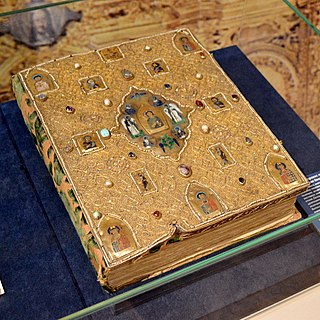
Mstislav Gospel is a 12th-century manuscript of the four Gospels on parchment in Old Church Slavonic. It is kept in the State Historical Museum in Moscow. The manuscript contains the text of the four Gospels on 213 parchment leaves. Its miniatures, headpieces, and illuminated initials are in several colors and contain copious amounts of gold.
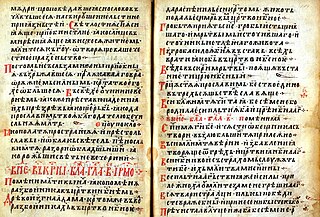
The Pirdop Apostle is a Bulgarian script book in Bulgarian language from Elena Basilica scriptorium near Pirdop, now kept in the SS. Cyril and Methodius National Library. It consists of the Acts of the Apostles with 130 surviving parchment leaves, the beginning and end parts being lost. It initially contained all the texts of the Acts and the Letters of the Apostles, but now only the Letters are preserved. It dates from the 13th century. In the 19th century the book was discovered immured in a niche of the church known as the "Elena Basilica" of "St. Elijah" monastery near to the small Bulgarian town of Pirdop. The Monastery and church was looted and completely destroyed by the Ottoman Army in 1700. According to a palaeographic analysis of the preserved transcript, this is a late counterfeit, probably from the first half of the 19th century.

The Gospel of Saint Nicholas is a Serbian illuminated manuscript written on parchment in 13th from the Monastery of St. Nicholas of Rošci, with size of 16x10.5 cm, 144 pages and 17 editions of text on each of the pages decorated with illuminations, initials and flags, gold and silver details. According to the historian Pavel Šafarik (1858), this Gospel he calls it "The Gospel of Queen Jelena", was written for Helen of Anjou, between 1240 and 1250.
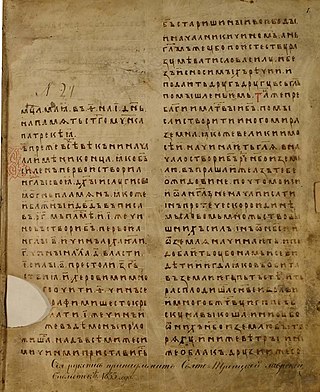
Palea is a monument or several interconnected monuments of the Old Russian literature, setting out the Old Testament history with additions from apocryphal monuments and some ancient Christian works, as well as with theological reasoning. A number of researchers consider palea as a monument of Byzantine origin, others consider it an ancient Russian work, since its Greek original is unknown.
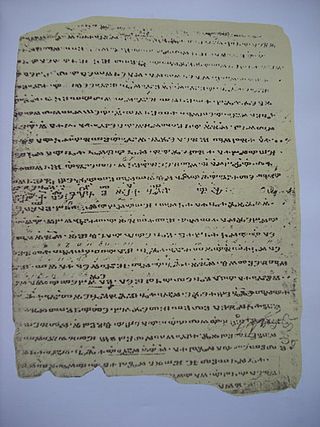
The Ohrid Gospel or Ohrid Glagothic fragments is a Glagolitic manuscript from the 10th century A.D. It contains text from the Gospel of Luke 24 and parts of the Gospel of John, written on 20 leaves of parchment, each about 17 by 20 cm each.

The Rila fragments are a Glagolitic manuscript consisting of eight fragmentary parchment leaves and three fragments of a 10th-century Glagolitic Old Church Slavonic book.

The Bojana Palimpsest or Bojana Gospel is an 11th-century Old Church Slavonic manuscript, originally written in a Glagolitic manuscript. In the 13th century, the Glagolitic text was removed, and the parchment was reused to write a Cyrillic gospel.